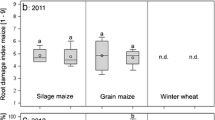Abstract
Several plant baits were tested to quantify Rhizoctonia inoculum density in Eucalyptus clonal garden soils. Experiments carried out with five types of plant baits in soils infested with R. solani showed that eucalypt twig segments were more readily colonised and allowed detection of the fungus at lower inoculum densities, showing high detection sensitivity across the tested clonal garden soils. Other baits had high colonisation levels, but varied greatly in sensitivity according to the tested soil. These results indicate that eucalypt twig segments were the most effective bait to estimate Rhizocronia inoculum density in clonal garden soils.
Similar content being viewed by others
References
Alfenas AC, Silveira SF, Sanfuentes E (1997) Current status and control strategies of disease associated to clonal propagation of Eucalyptus in Brazil. In ‘Silviculture and improvement of Eucalyptus’. Vol. 3. IUFRO Conference. pp. 106–111. (EMBRAPA. Centro Nacional de Pesquisas Florestais: Colombo, Brazil)
Baker KF (1970) Types of Rhizoctonia diseases and their occurrence. In ‘Rhizoctonia solani, biology and pathology’. (Ed. JR Parmeter) pp. 78–89. (University of California Press: Berkeley, CA)
Boosalis MG, Scharen AL (1959) Methods for microscopic detection of Aphanomyces euteiches and Rhizoctonia solani and for isolation of Rhizoctonia solani associated with plant debris. Phytopathology 49, 192–198.
Bouhot D (1979) Estimation of inoculum density and inoculum potential: techniques and their value for disease prediction. In ‘Soilborne plant pathogens’. (Eds B Schippers, W Gams) pp. 379–390. (Academic Press: New York, NY)
Campbell CL, Madden LV (1990) ‘Introduction to plant disease epidemiology.’ (John Wiley & Sons: New York, NY)
Garrett SD (1970) ‘Pathogenic root-infecting fungi.’ (Cambridge University Press: New York, NY)
Henis Y, Ben-Yephet Y (1970) Effect of propagule size of Rhizoctonia solani on saprophytic growth, infectivity, and virulence on bean seedlings. Phytopathology 60, 1351–1356.
Henis Y, Ghaffar A, Baker R, Gillespie SL (1978) A new pellet soil-sampler and its use for the study of population dynamics of Rhizoctonia solani in soil. Phytopathology 68, 371–376.
Huang JW, Kuhlman EG (1989) Recovery and pathogenicity of Rhizoctonia solani and binucleate Rhizoctonia-like fungi in forest nurseries. Plant Disease 73, 968–972.
Ko W, Hora F (1971) A selective medium for the quantitative determination of Rhizoctonia solani in soil. Phytopathology 61, 707–710.
Lewis JA, Larkin RP, Rogers DL (1998) A formulation of Trichoderma and Gliocladium to reduce damping-off caused by Rhizoctonia solani and saprophytic growth of the pathogen in soilless mix. Plant Disease 82, 501–506.
Lewis JA, Lumsden RD, Locke JC (1996) Biocontrol of damping-off diseases caused by Rhizoctonia solani and Pythium ultimun with alginate prills of Gliocladium virens, Trichoderma hamatum and various food bases. Biocontrol Science and Technology 6, 163–173.
Lewis JA, Papavizas GC (1985) Characteristics of alginate pellets formulated with Trichoderma and Gliodadium and their effect on the proliferation of the fungi in soil. Plant Pathology 34, 571–577.
Lewis JA, Papavizas GC (1987) Reduction of inoculum of Rhizoctonia solani in soil by germlings of Trichoderma hamatum. Soil Biology and Biochemistry 19, 195–201.
Martinson CA (1963) Inoculum potential relationships of Rhizoctonia solani measured with soil microbiological sampling tubes. Phytopathology 53, 634–638.
Papavizas GC (1970) Colonization and growth of Rhizoctonia solani in soil. In ‘Rhizoctonia solani, biology and pathology’. (Ed. JR Parmeter) pp. 153–170. (University of California Press: Berkeley, CA)
Papavizas GC, Adams PB, Lumdsen RD, Lewis JA, Dow LR, Ayers WA, Kantzes JG (1975) Ecology and epidemiology of Rhizoctonia solani in field soil. Phytopathology 65, 871–877.
Papavizas GC, Davey CB (1959) Isolation of Rhizoctonia solani Kuhn from naturally infested and artificially inoculated soils. Plant Disease Reporter 43, 404–410.
Papavizas GC, Davey CB (1961) Saprophytic behavior of Rhizoctonia in soil. Phytopathology 51, 693–699.
Papavizas GC, Davey CB (1962) Isolation and pathogenicity of Rhizoctonia saprophytically existing in soil. Phytopathology 52, 834–840.
Sanfuentes E (2001) Caracterizaçao de isolados, flutuaçao populacional e controle biológico de Rhizoctonia em jardim clonal de Eucalyptus. PhD Thesis, Universidade Federal de Viçosa, Viçosa, Brasil.
Sanfuentes E, Alfenas AC (1998) Evaluation of saprophytic capacity and pathogenicity of Rhizoctonia spp. in the clonal propagation system of Eucalyptus. In ‘7th International congress of plant pathology’. Vol. 3. Edinburgh, Scotland. (Abstract 3.7.37.)
Schisler DA, Neate SM, Masuhara G (1994) The occurrence and pathogenicity of Rhizoctonia fungi in South Australian plant nurseries. Mycological Research 98, 77–82.
Silveira SF (1996) Etiologia e controle da mela de estacas e da queima de folhas de eucalipto, causada por Rhizoctonia spp. PhD Thesis, Universidade Federal de Viçosa, Viçosa, Brasil.
Silveira SF, Alfenas AC, Ferreira FA, Sutton JC (2000) Characterization of Rhizoctonia species associated with foliar necrosis and leaf scorch of clonally-propagated Eucalyptus in Brazil. European Journal of Plant Pathology 106, 27–36.
Sneh B, Burpee L, Ogoshi A (1991) ‘Identification of Rhizoctonia species.’ (APS Press: St Paul, MN)
Sneh B, Katan J, Henis Y, Wahl I (1966) Methods for evaluating inoculum density of Rhizoctonia in naturally infested soil. Phytopathology 56, 74–78.
Van Bruggen AHC (1986) Quantitative recovery of Rhizoctonia solani from soil. Plant Disease 70, 320–323.
Van Der Plank JE (1975) ‘Principles of plant infection.’ (Academic Press Inc.: New York, NY)
Villajuan-Abgona R, Katsuno N, Kageyama K, Hyakumachi M (1996) Isolation and identificati on of hypovirulent Rhizoctonia spp. from soil. Plant Pathology 45, 896–904.
Weinhold AR (1977) Population of Rhizoctonia solani in agricultural soils determined by a screening procedure. Phytopathology 67, 566–569.
Windham AS, Lucas LT (1987) A qualitative baiting technique for selective isolation of Rhizoctonia zeae from soil. Phytopathology 77, 712–714.
Author information
Authors and Affiliations
Corresponding author
Rights and permissions
About this article
Cite this article
Saufuentes, E., Alfenas, A.C., Maffia, L.A. et al. Comparison of baits to quantify inoculum density of Rhizoctonia spp. in Eucalyptus clonal garden soils. Australasian Plant Pathology 31, 177–183 (2002). https://doi.org/10.1071/AP02004
Received:
Accepted:
Issue Date:
DOI: https://doi.org/10.1071/AP02004




